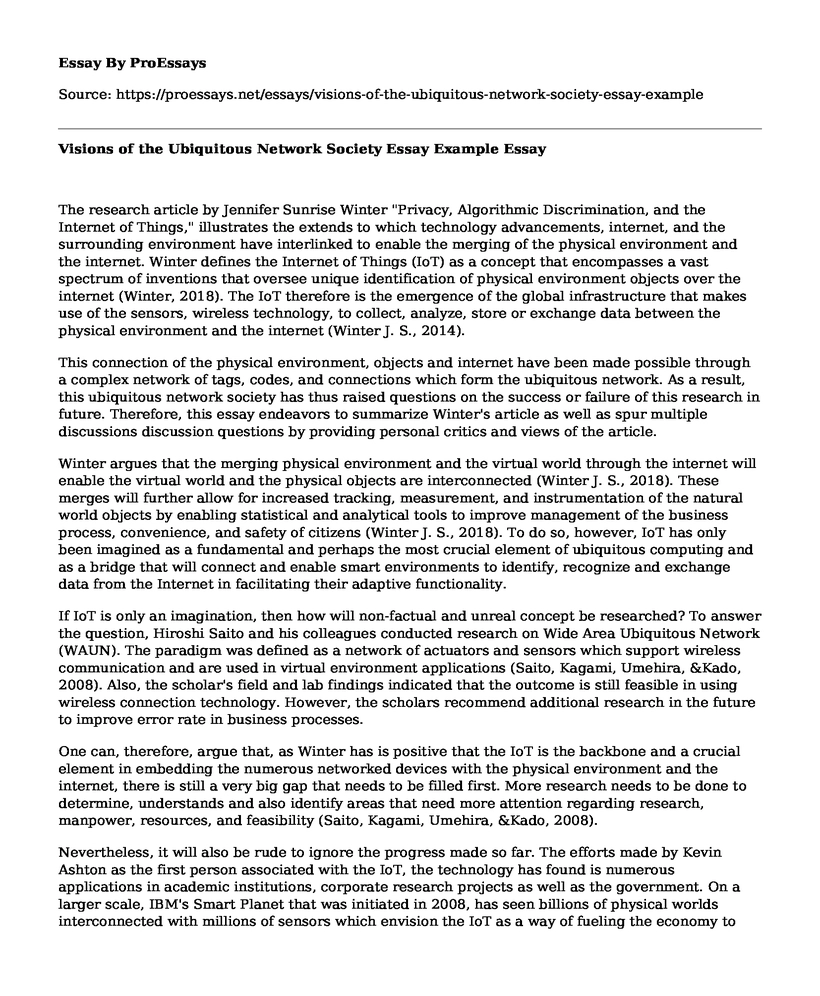The research article by Jennifer Sunrise Winter "Privacy, Algorithmic Discrimination, and the Internet of Things," illustrates the extends to which technology advancements, internet, and the surrounding environment have interlinked to enable the merging of the physical environment and the internet. Winter defines the Internet of Things (IoT) as a concept that encompasses a vast spectrum of inventions that oversee unique identification of physical environment objects over the internet (Winter, 2018). The IoT therefore is the emergence of the global infrastructure that makes use of the sensors, wireless technology, to collect, analyze, store or exchange data between the physical environment and the internet (Winter J. S., 2014).
This connection of the physical environment, objects and internet have been made possible through a complex network of tags, codes, and connections which form the ubiquitous network. As a result, this ubiquitous network society has thus raised questions on the success or failure of this research in future. Therefore, this essay endeavors to summarize Winter's article as well as spur multiple discussions discussion questions by providing personal critics and views of the article.
Winter argues that the merging physical environment and the virtual world through the internet will enable the virtual world and the physical objects are interconnected (Winter J. S., 2018). These merges will further allow for increased tracking, measurement, and instrumentation of the natural world objects by enabling statistical and analytical tools to improve management of the business process, convenience, and safety of citizens (Winter J. S., 2018). To do so, however, IoT has only been imagined as a fundamental and perhaps the most crucial element of ubiquitous computing and as a bridge that will connect and enable smart environments to identify, recognize and exchange data from the Internet in facilitating their adaptive functionality.
If IoT is only an imagination, then how will non-factual and unreal concept be researched? To answer the question, Hiroshi Saito and his colleagues conducted research on Wide Area Ubiquitous Network (WAUN). The paradigm was defined as a network of actuators and sensors which support wireless communication and are used in virtual environment applications (Saito, Kagami, Umehira, &Kado, 2008). Also, the scholar's field and lab findings indicated that the outcome is still feasible in using wireless connection technology. However, the scholars recommend additional research in the future to improve error rate in business processes.
One can, therefore, argue that, as Winter has is positive that the IoT is the backbone and a crucial element in embedding the numerous networked devices with the physical environment and the internet, there is still a very big gap that needs to be filled first. More research needs to be done to determine, understands and also identify areas that need more attention regarding research, manpower, resources, and feasibility (Saito, Kagami, Umehira, &Kado, 2008).
Nevertheless, it will also be rude to ignore the progress made so far. The efforts made by Kevin Ashton as the first person associated with the IoT, the technology has found is numerous applications in academic institutions, corporate research projects as well as the government. On a larger scale, IBM's Smart Planet that was initiated in 2008, has seen billions of physical worlds interconnected with millions of sensors which envision the IoT as a way of fueling the economy to higher scale. The concept is also promising in the figured prominent in the national and international tech policy strategies (Winter J. S., 2014).
Conclusion
In conclusion, although the concept has great potential and very promising especially in the current economy, is crucial to consider these two questions; first, to uniquely identify the numerous objects in the physical environment, it means that more identification sensors are required, will the cost outweigh the benefits. Secondly, if the project is to be seen through, is the research done adequately to initiate the project?
References
Saito, H., Kagami, O., Umehira, M., & Kado, Y. (2008). Wide area ubiquitous network: the network operator's view of a sensor network. IEEE Communication Magazine, 112-120.
Winter, J. S. (2014). Surveillance in ubiquitous network societies: normative conflicts related to the consumer in-store supermarket experience in the context of the Internet of Things. Ethics and Information Technology, 27-41.
Winter, J. S. (2018). Privacy, algorithmic discrimination, and the internet of things (Fourth ed.). (E. o. Technology, Ed.) Hershey, PA: IGI Global.
Cite this page
Visions of the Ubiquitous Network Society Essay Example. (2022, Nov 20). Retrieved from https://proessays.net/essays/visions-of-the-ubiquitous-network-society-essay-example
If you are the original author of this essay and no longer wish to have it published on the ProEssays website, please click below to request its removal:
- Is the Gender Gap Persistent in America? - Research Paper
- Building the Wall - Essay Sample
- Should Juveniles Receive Life Sentences and Tried as Adults - Essay Sample
- Innovative Construction Project of Saudi Aramco Paper Example
- Paper Example on Chief Police and Community: Securing Relationships to End Injustice
- R v. Lucas: Defamation Suit Upholded by Supreme Court - Essay Sample
- Social Location: Understanding Its Impact on Our Development - Essay Sample







